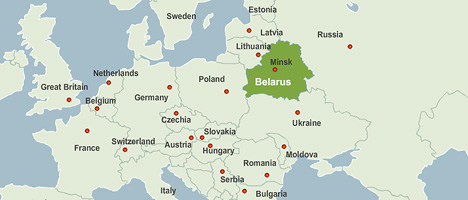Key facts about Belarus

Belarus on the map of Europe
An introduction in facts and figures to this landlocked country in the north-east of Europe
Official Name
Republic of Belarus
President of Belarus
Aleksandr Lukashenko (1994 - present )
Prime Minister of Belarus
Roman Golovchenko (appointed prime minister on 4 June 2020)
Total land area of Belarus
207,600 km²
Nationality of Belarus
Population – 9.155,9 million (on 1 January 2024)
-
Life expectancy at birth – 74.5 years
-
Population living in cities – 78%
-
The capital is Minsk – 1.992,8 million inhabitants
Regional centres of Belarus (on 1 January 2024):
-
Brest Oblast – 1.308,5 million inhabitants (Brest – 344,4 thousand)
-
Vitebsk Oblast – 1.081,9 million inhabitants (Vitebsk – 358,3 thousand)
-
Gomel Oblast – 1.338,6 million inhabitants (Gomel – 501,1 thousand)
-
Grodno Oblast – 992,5 thousand inhabitants (Grodno – 361,1 thousand)
-
Mogilev Oblast – 981,1 thousand inhabitants (Mogilev – 353,1 thousand)
-
Minsk Oblast – 1.460,2 million inhabitants
Ethnicity
|
Belarusian |
84.9% |
|
(Source: 2019 census) | |
Languages spoken in Belarus
Belarusian and Russian
National holidays in Belarus
Independence Day, 3 July
Currency of Belarus
Belarusian rouble (Br)
Economic indicators
GDP (2023) Br 216.1 billion
GDP (2022) Br 191.4 billion; per capita: Br20.73 thousand
GDP (2021) Br 176.8 billion; per capita: Br19.01 thousand
GDP (2020) Br 149.7 billion; per capita: Br15.96 thousand
GDP (2019) Br134.7 billion; per capita: Br14.30 thousand
Foreign merchandise trade by type of economic activity (in million USD, 2021)
EXPORT / IMPORT
Agriculture, forestry and fisheries - 587.7 / 1,559.8
Manufacturing - 36,949.2 / 38,489.1
- mining - 1,150.4 / 10,343.8
- processing - 35,604.5 / 27,579.5
- supply of electricity, gas, steam, hot water and conditioned air - 66.8 / 21.2
- water supply; collection, processing and disposal of waste, pollution cleanup - 127.5 / 544.6
Main Business Partners of Belarus (2021)
Export:
-
Russia
-
Ukraine
-
Netherlands
-
Poland
-
Germany
Import:
-
Russia
-
China
-
Germany
-
Ukraine
-
Poland
Main Industries of Belarus
-
metallurgical
-
mechanical engineering, including tractors and agricultural, cars, machine-tool constructing and tool industry, instrument making, radio engineering, electro technical, electronic, optics-mechanical industry; and metal working
-
chemical and petrochemical
-
light industry
-
food industry
Belarus ranked 47th out of 152 countries in the 2020 edition of the Competitive Industrial Performance Index (CIP) that is compiled by the United Nations Industrial Development Organization.
Area of farmland in Belarus
8,283,900 hectares (as of late 2020)
Agriculture
Areas of speciality in agriculture: grain, potatoes, vegetables, sugar beet, flax, meat and dairy industry
Natural resources
- wood
-
peat
-
potash and rock salts
-
small oil and natural gas fields
-
granite
-
dolomite
-
limestone
-
clay
-
sand
Number of people in employment
4.14 million (2023)
Breakdown of employed population by type of economic activity (2022):
-
production sector – 23.8%
-
wholesale and retail trade; repairs of automobiles – 14.3%
-
education – 10.4%
- agriculture, forestry, fishing industry – 8.6%
-
transportation, storage, postal services and courier delivery – 6.7%
-
civil engineering – 6.1%
- information and communications – 3.3%
-
others – 26.8%
Unemployment in Belarus
172.1 thousand unemployed (2023)
Communications
Number of mobile communication subscribers – 11.77 million (2022).
Penetration of LTE-powered mobile communication services – 98%. At present the services are available in Minsk and all the oblast capitals as well as major district capitals across the country.
Number of fixed telephony subscribers – 47.5 phones per 100 residents.
Number of Internet service subscribers and users – over 12 million, including over 3.2 million of fixed broadband Internet access subscribers.
International bandwidth – 2,770 Gbps (2022)
Belarus is ranked 32nd in the Global ICT Development Index of the International Telecommunication Union (2017).
In the comparative Integrated Index for Postal Development by the Universal Postal Union the Belarusian postal service is ranked 20th out of 170 postal service operators in 2020 (21st out of 172 countries in 2019).
In 2020, Belarus reached the 40th position in the UN E-Government Survey (the index features a total of 193 countries).
Transportation
Railways – 5.474,1 km, including 1.369,5 km of electric track (2022)
Highways – 103,400 km, including paved roads 90,100 km (2022)
Oil pipelines – 2,766.3 km
Oil product pipelines – 1,137.9 km
Gas pipelines – 7,901.6 km
